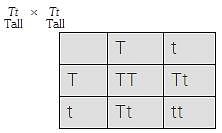Test: Genetics - 2 - Class 10 MCQ
15 Questions MCQ Test Science Class 10 - Test: Genetics - 2
How many types of gametes will be produced in F2 generation of a monohybrid cross of Mendel :-
Considering tallness and dwarfness, tallness is more wide spread among pea plants because :-
| 1 Crore+ students have signed up on EduRev. Have you? Download the App |
A red-flowered pea plant was crossed with white-flowered plant. In F1 generation all plants were red. It confirms that white colour is :-
A woman with straight hair mates with a man with curly hair who is known to be heterozygous for that trait. What is the chance that their first child will have curly hair :-
The main reason of Mendel's successs in discovering the principles of inheritance was :-
Mendel was lucky in the choice of the material of his experiments, among the following, which contributed, to his success ?
An organism with two identical alleles of a gene is a cell is called :-
When an individual is having both the alleles of contrasting characters it is said to be :-
If a plant is heterozygous for tallness, the F2 generation has both tall and dwarf plants. This proves the principle of :-
Mendel crossed a pure white flowered recessive pea plant with a dominant pure red flowered plant. The first generation of hybrids from the cross should show :-
If a couple has three daughters, what are the chances that the fourth child will be a son ?
If a heterozygous tall palnt is crossed with a homozygous dwarf palnt, the proportion of dwarf progeny will:-
|
85 videos|437 docs|75 tests
|



















